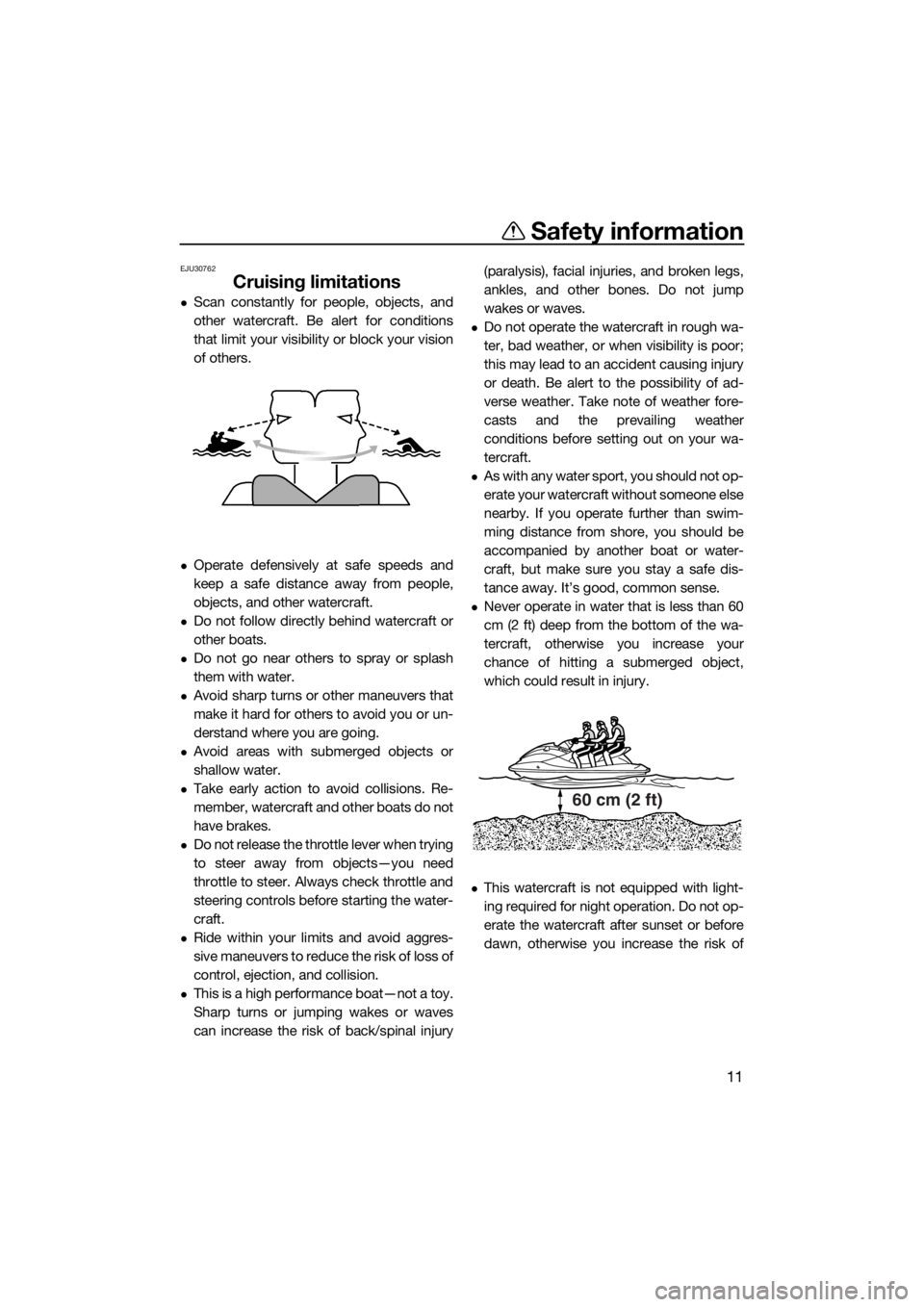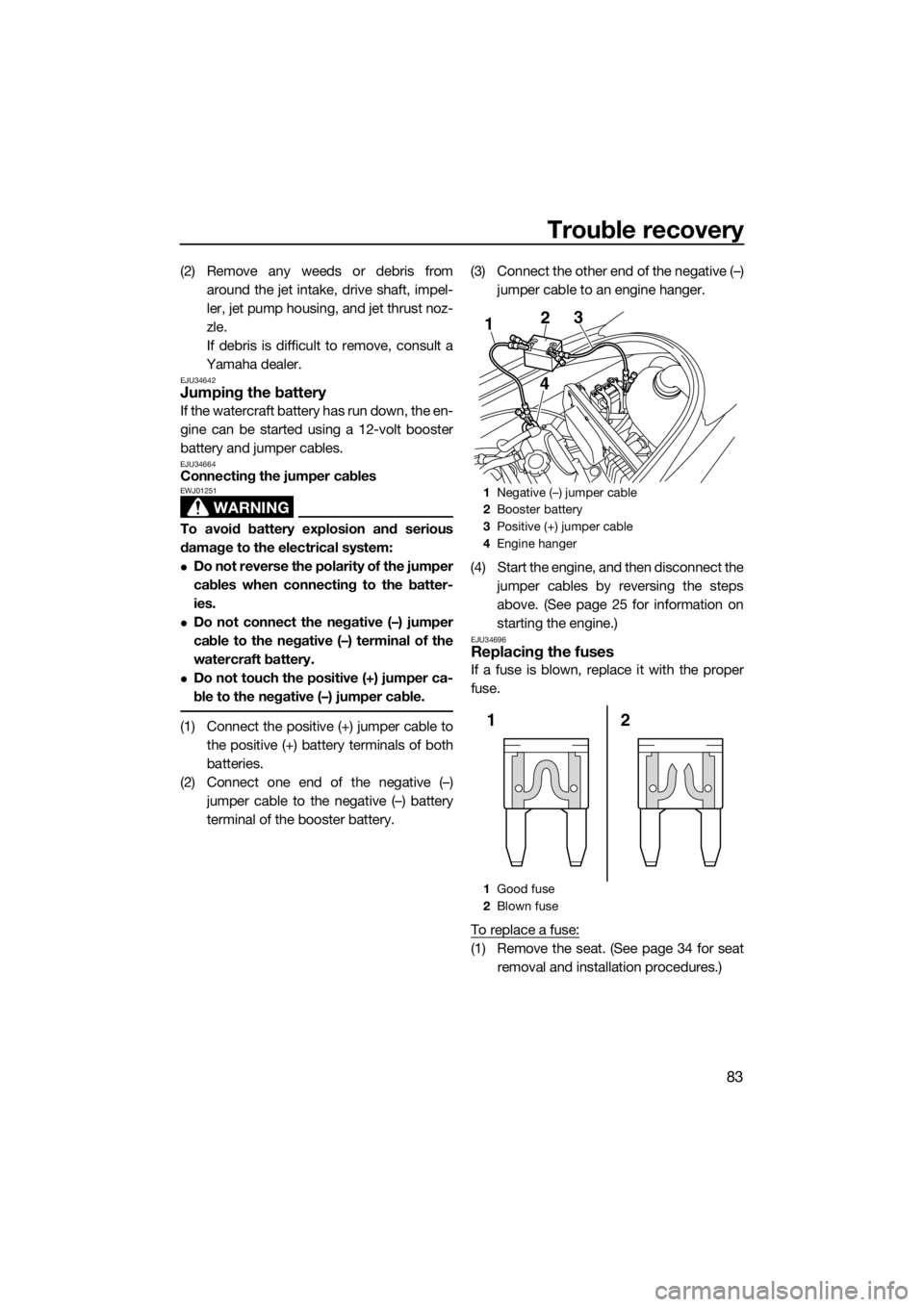jump start YAMAHA V1 2015 Owners Manual
[x] Cancel search | Manufacturer: YAMAHA, Model Year: 2015, Model line: V1, Model: YAMAHA V1 2015Pages: 94, PDF Size: 3.01 MB
Page 6 of 94

Table of contents
Learning to operate your
watercraft ...................................... 56
Riding position ................................. 57
Launching the watercraft ................. 57
Starting the engine on water ............ 57
Stopping the engine ......................... 58
Leaving the watercraft...................... 58
Operating the watercraft .................. 58
Turning the watercraft ...................... 59
Stopping the watercraft ................... 61
Operating the watercraft in reverse
(V1 Sport) ...................................... 61
Boarding the watercraft ................... 62
Starting off........................................ 65
Capsized watercraft ......................... 66
Beaching and docking the
watercraft ...................................... 67
Operating in weeded areas .............. 67
After removing the watercraft from
the water ....................................... 68
Care and storage............................. 69
Post-operation care ...................... 69
Flushing the cooling water
passages....................................... 69
Cleaning the watercraft .................... 70
Battery care ...................................... 70
Long-term storage ........................ 73
Cleaning ........................................... 73
Lubrication ....................................... 73
Rustproofing..................................... 74
Maintenance .................................... 75
Maintenance.................................. 75
Tool kit.............................................. 75
Periodic maintenance chart ............. 76
Engine oil and oil filter ...................... 77
Specifications .................................. 78
Specifications................................ 78
Trouble recovery ............................. 79
Troubleshooting ............................ 79
Troubleshooting chart ...................... 79
Emergency procedures ................ 82
Cleaning the jet intake and
impeller ......................................... 82
Jumping the battery ......................... 83
Replacing the fuses .......................... 83
Towing the watercraft....................... 85
Submerged watercraft ..................... 85
Index................................................. 86
UF2P72E0.book Page 2 Tuesday, August 26, 2014 10:08 AM
Page 17 of 94

Safety information
11
EJU30762
Cruising limitations
Scan constantly for people, objects, and
other watercraft. Be alert for conditions
that limit your visibility or block your vision
of others.
Operate defensively at safe speeds and
keep a safe distance away from people,
objects, and other watercraft.
Do not follow directly behind watercraft or
other boats.
Do not go near others to spray or splash
them with water.
Avoid sharp turns or other maneuvers that
make it hard for others to avoid you or un-
derstand where you are going.
Avoid areas with submerged objects or
shallow water.
Take early action to avoid collisions. Re-
member, watercraft and other boats do not
have brakes.
Do not release the throttle lever when trying
to steer away from objects—you need
throttle to steer. Always check throttle and
steering controls before starting the water-
craft.
Ride within your limits and avoid aggres-
sive maneuvers to reduce the risk of loss of
control, ejection, and collision.
This is a high performance boat—not a toy.
Sharp turns or jumping wakes or waves
can increase the risk of back/spinal injury(paralysis), facial injuries, and broken legs,
ankles, and other bones. Do not jump
wakes or waves.
Do not operate the watercraft in rough wa-
ter, bad weather, or when visibility is poor;
this may lead to an accident causing injury
or death. Be alert to the possibility of ad-
verse weather. Take note of weather fore-
casts and the prevailing weather
conditions before setting out on your wa-
tercraft.
As with any water sport, you should not op-
erate your watercraft without someone else
nearby. If you operate further than swim-
ming distance from shore, you should be
accompanied by another boat or water-
craft, but make sure you stay a safe dis-
tance away. It’s good, common sense.
Never operate in water that is less than 60
cm (2 ft) deep from the bottom of the wa-
tercraft, otherwise you increase your
chance of hitting a submerged object,
which could result in injury.
This watercraft is not equipped with light-
ing required for night operation. Do not op-
erate the watercraft after sunset or before
dawn, otherwise you increase the risk of
60 cm (2 ft)
UF2P72E0.book Page 11 Tuesday, August 26, 2014 10:08 AM
Page 89 of 94

Trouble recovery
83
(2) Remove any weeds or debris from
around the jet intake, drive shaft, impel-
ler, jet pump housing, and jet thrust noz-
zle.
If debris is difficult to remove, consult a
Yamaha dealer.
EJU34642Jumping the battery
If the watercraft battery has run down, the en-
gine can be started using a 12-volt booster
battery and jumper cables.
EJU34664Connecting the jumper cables
WARNING
EWJ01251
To avoid battery explosion and serious
damage to the electrical system:
Do not reverse the polarity of the jumper
cables when connecting to the batter-
ies.
Do not connect the negative (–) jumper
cable to the negative (–) terminal of the
watercraft battery.
Do not touch the positive (+) jumper ca-
ble to the negative (–) jumper cable.
(1) Connect the positive (+) jumper cable to
the positive (+) battery terminals of both
batteries.
(2) Connect one end of the negative (–)
jumper cable to the negative (–) battery
terminal of the booster battery.(3) Connect the other end of the negative (–)
jumper cable to an engine hanger.
(4) Start the engine, and then disconnect the
jumper cables by reversing the steps
above. (See page 25 for information on
starting the engine.)
EJU34696Replacing the fuses
If a fuse is blown, replace it with the proper
fuse.
To replace a fuse:
(1) Remove the seat. (See page 34 for seat
removal and installation procedures.)
1Negative (–) jumper cable
2Booster battery
3Positive (+) jumper cable
4Engine hanger
1Good fuse
2Blown fuse
1
43
2
2 1
UF2P72E0.book Page 83 Tuesday, August 26, 2014 10:08 AM
Page 92 of 94

86
Index
A
After removing the watercraft from the
water ..................................................... 68
B
Battery care.............................................. 70
Battery checks ......................................... 50
Battery, jumping ....................................... 83
Beaching and docking the watercraft ...... 67
Beverage holder ....................................... 38
Bilge water check..................................... 50
Bilge water, draining ................................ 43
Bilge water, draining on land ................... 43
Bilge water, draining on water ................. 44
Boarding alone ......................................... 62
Boarding and starting off from a dock ..... 66
Boarding the watercraft ........................... 62
Boarding with passenger(s) ..................... 63
Bow eye ................................................... 35
Bow storage compartment ...................... 36
Builder’s plate ............................................ 2
C
Capsized watercraft ................................. 66
Check engine warning ............................. 33
Cleaning ................................................... 73
Cleaning the watercraft ............................ 70
Cleat ......................................................... 36
Cooling water pilot outlet ......................... 27
Cooling water pilot outlet check .............. 55
Craft Identification Number (CIN)............... 1
Cruising limitations................................... 11
E
Emergency procedures ............................ 82
Engine break-in ........................................ 46
Engine compartment check ..................... 49
Engine idling speed check ....................... 55
Engine oil ................................................. 42
Engine oil and oil filter .............................. 77
Engine oil level check............................... 49
Engine oil requirements ........................... 42
Engine overheat warning ......................... 32
Engine serial number ................................. 1
Engine shut-off cord (lanyard) check ....... 52
Engine shut-off switch ............................. 25
Engine stop switch................................... 25
Engine unit check..................................... 49Enjoy your watercraft responsibly ............ 19
Equipment ................................................ 34
F
Fire extinguisher check ............................ 53
Fire extinguisher holder and cover........... 38
Fire extinguisher holder, cover, and
band checks ......................................... 53
Flushing the cooling water passages....... 69
Fuel .......................................................... 40
Fuel level check........................................ 49
Fuel level meter ........................................ 31
Fuel level warning..................................... 31
Fuel requirements .................................... 40
Fuel system checks ................................. 49
Fuses, replacing ....................................... 83
G
Getting to know your watercraft .............. 56
Glossary, watercraft ................................. 20
Glove compartment ................................. 37
H
Handgrip .................................................. 34
Hazard information................................... 15
Hood check .............................................. 54
Hour meter/voltmeter ............................... 30
Hull and deck check ................................ 54
I
Identification numbers ............................... 1
Information display................................... 29
J
Jet intake and impeller, cleaning.............. 82
Jet intake checks ..................................... 54
Jumper cables, connecting ...................... 83
L
Labels, important ....................................... 4
Labels, other .............................................. 8
Labels, warning .......................................... 5
Launching the watercraft ......................... 57
Learning to operate your watercraft......... 56
Leaving the watercraft.............................. 58
Limitations on who may operate the
watercraft .............................................. 10
Long-term storage ................................... 73
Lubrication ............................................... 73
M
Main components, location of ................. 21
UF2P72E0.book Page 86 Tuesday, August 26, 2014 10:08 AM